 What is Alabama Rot? Do you like taking your dog/s for long walks in the forest and countryside or off the beaten track? You may be worried and surprised to learn that there is a very serious disease that dogs are contracting. It does seem to be more prevalent in country areas. The inference is that muddy and boggy areas could be harbouring this disease.
What is Alabama Rot? Do you like taking your dog/s for long walks in the forest and countryside or off the beaten track? You may be worried and surprised to learn that there is a very serious disease that dogs are contracting. It does seem to be more prevalent in country areas. The inference is that muddy and boggy areas could be harbouring this disease.
Please share
UPDATE – December 2019
These are the latest figures for Alabama Rot otherwise known as renal glomerular vasculopathy (CRGV). To date, there have now been 198 confirmed cases of Alabama rot across 40 counties, since 2012.
The five latest confirmed cases are located in Wallingford (Oxfordshire), Horsham (West Sussex), Malmesbury (Wiltshire) and two in Hungerford (Berkshire) as confirmed by Vet Times. They have also given a breakdown of how many cases have been confirmed since the first case in 2012, as follows:
-
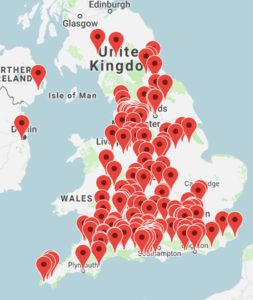
confirmed case up to 2019 6 in 2012
- 5 in 2013
- 32 in 2014
- 21 in 2015
- 19 in 2016
- 40 in 2017
- 52 in 2018
- 23 so far in 2019
Please share this post with those you know have dogs. It is vital that all dog owners know about this devastating disease and by sharing you may save lives. You can see the increase in confirmed cases comparing this may from the older map below.
First identified in Alabama
There is little known about the infection except it is thought to have first been identified in greyhounds in the state of Alabama during the 1980s. There weren’t that many cases and as numbers contracting the disease seemed to dwindle. Nothing much was done and research into the disease was put on the back burner.
CRGV more information
It is officially known as CRGV (Cutaneous and renal glomerular vasculopathy) as well as Alabama Rot. This disease causes damage to blood vessels of the skin and also damage to the kidneys.
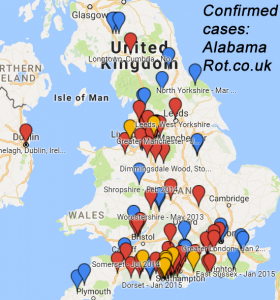 In the UK since 2012
In the UK since 2012
But now it has reared its ugly head within the UK since 2012. Although only 102 cases have been confirmed, with another 57 suspected, (see UPDATE above) the disease is often fatal. The cause of death being due to kidney failure. Because it is a little known disease, it is often diagnosed too late for the hapless canine. Luckily it does seem that it is not crossing the species barrier with other pets. So cats and rabbits are seemingly unaffected.
Started in The New Forest, Hampshire UK
The New Forest in Hampshire, UK has so far taken the brunt of this horrid disease. But now it has spread to other areas, including Devon, Dorset, Monmoushire, Cheshire Worcestershire, Warwickshire and the Greater Manchester area. Now it appears that Cornwall has been hit.
Which areas are most dangerous?
There is much speculation as to where this disease lingers with specific areas of the 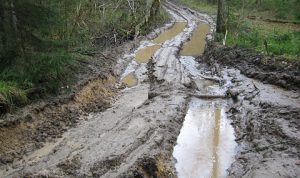 countryside not yet being identified as dangerous. The Forestry Commission, does remind dog owners though, that the numbers struck by the condition are very few. But this is no consolation to those who have had their dog succumb to the illness. Or perhaps know of a neighbour or someone in their area who has lost their beloved pet.
countryside not yet being identified as dangerous. The Forestry Commission, does remind dog owners though, that the numbers struck by the condition are very few. But this is no consolation to those who have had their dog succumb to the illness. Or perhaps know of a neighbour or someone in their area who has lost their beloved pet.
What can we do?
So if we don’t know exactly what causes the disease and what places to avoid, what can we do to protect our dogs? We have got a few clues with the majority of the outbreaks happening between the months of November and June. This would indicate that the problem may occur more in the wettest part of the year ie. the Winter and Spring.
Watch out for the symptoms
The infected dog seems to suffer from lesions and sores on the lower parts of the legs and sometimes the stomach and face area which again could indicate some sort of condition due to mud or walking and running through muddy water, slurry or waterlogged areas. It is advised that any mud and dirt on the dog be washed off as soon as possible.
Leptospirosis too!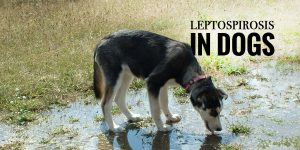
Apart from being on the alert for stagnant, boggy and muddy areas, putting your dog on the lead through these regions or perhaps avoiding them altogether, could be a good idea. This practice may also avoid leptospirosis which is thought to be contracted from drinking from stagnant ponds and dirty water. The Leptospirosis vaccine given to those dogs susceptible to the disease has poor efficacy and also contains mercury. Our two pups both had a serious reaction from this vaccine when our vet gave it to them without asking us first. Given the option, we would have refused this non core vaccine.
Lepto vaccine contains mercury
It would appear that this particular vaccine causes some serious side effects and the fact that BOTH our pups had a serious reaction would confirm this fact. This vaccine contains a powerful adjuvant that triggers a strong immune system response and carries a much greater risk for adverse reactions than other vaccines. Leptospirosis can be treated if detected early, so be on the alert. If a lepto infection is entirely treatable, why vaccinate? My answer is – follow the money!
Dr Becker says…
“I’ve handled about a dozen cases of lepto in my career and have never had a dog experience any lingering problems from the infection. I recommend you skip the leptospirosis vaccine.”
Check your dog after each walk
The first signs of Alabama Rot is lesions, swelling, sores or red areas on the legs, feet, stomach or face. If you know your dog has not been injured, be suspicious and get the dog checked immediately. Your dog may also lose hair and/or lick the affected area. If these symptoms are not spotted, your dog will show outward signs of kidney failure ie. depression, lack of appetite and vomiting and the kidneys could be seriously damaged.
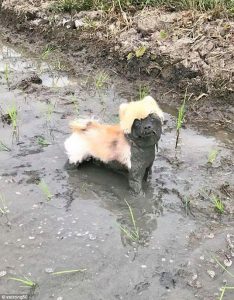 Be diligent!
Be diligent!
It would appear that as many as 90% of those infected succumb to this disease. It is always a good idea to get into the habit of checking your dog over when you’ve finished your walk anyway. After cleaning off any mud and muck, look for lumps and bumps, sore areas, cuts and injuries. Dogs can get injured without you knowing, they are brave creatures and will not make too much of a fuss if they are hurt. If your dog starts licking himself more than usual, check out the area. Watch your dog for signs of listlessness or acting out of character.
Chemical contamination ruled out
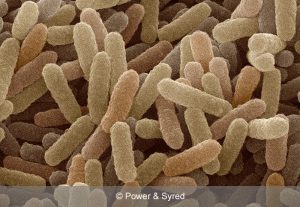
The British Environment Agency has ruled out chemical contamination and experts do believe that this disease is similar to Alabama Rot, hence the name being bandied about. Despite a lack of evidence it is thought that a toxin produced by the E. Coli bacteria could be the culprit. More research is called for to confirm exactly what is causing this lethal infection.
A healthy immune system is the best defence
Although I sometimes digress from the subject of this site as I have with this post, I like to remind all of us about Magnesium’s benefits. That includes the benefits this vital mineral gives our beloved pets. Putting a few drops of Mg Chloride solution in your dog’s water will keep him in fine fettle. Or you could also use a sprinkle of tasteless Mg citrate powder on his food.
As well as us, animals can also suffer from a lack of Mg and this will have a direct affect on their wellbeing. If your pets are fit and healthy, they will be less likely to succumb to diseases. A healthy immune system will protect your precious pets against pathogens.
 Mg deficiency in farm animals
Mg deficiency in farm animals
It is always amazing to me how farmers know how to treat their animals. They know about Mg deficiency. But doctors have no idea what to do to keep us humans replete in this essential mineral. Maybe it’s something to do with money? A farmer could lose his animals because of a Mg deficiency. Hence he will lose money, so he will supplement his animals’ food with Mg.
Mg deficiency in humans
If a doctor sees a patient who is sick because of a Mg deficiency that patient will not be giving a Mg supplement. Instead he will prescribe a drug which will make the pharmaceutical company money. It will likely have the result that the patient is prescribed that drug for life. I wonder how many pharmaceutical drugs actually cure an illness rather than control it… Or dare I say, make it worse?
To summarise
Despite ‘Alabama Rot’ being quite a rare disease, please be aware and check your dog isn’t getting into muddy and mucky areas. Put your dog on the lead to avoid boggy paths, stagnant ponds and muddy tracks. Shower off any mud and dirt as soon as you return home. Don’t hesitate going to your vet if you are suspicious about anything, better safe than  sorry. Keep your dog fit with good quality foods with no wheat or artificial additives and only natural ingredients. Change his water frequently and add a few drops of Mg Chloride to it and/or Mg citrate powder to his food. Our precious pets are part of our family and we must do our best to keep them healthy, happy and content just like we do for all our other family members. Please don’t forget to share this post, it could save the life of a precious pet.
sorry. Keep your dog fit with good quality foods with no wheat or artificial additives and only natural ingredients. Change his water frequently and add a few drops of Mg Chloride to it and/or Mg citrate powder to his food. Our precious pets are part of our family and we must do our best to keep them healthy, happy and content just like we do for all our other family members. Please don’t forget to share this post, it could save the life of a precious pet.